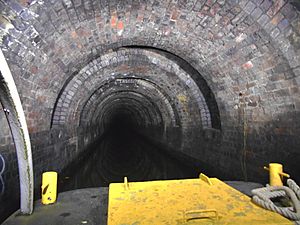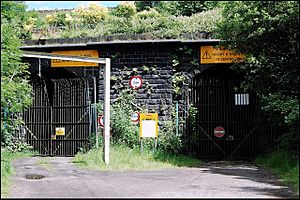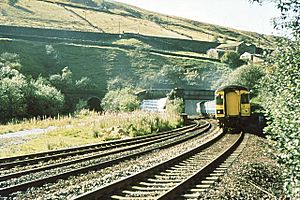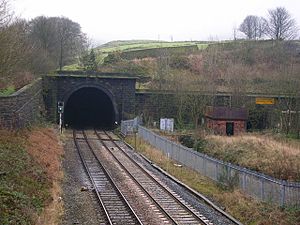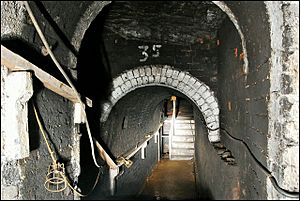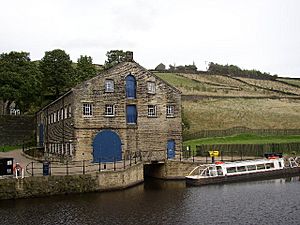Standedge Tunnels facts for kids
 |
|
| Tunnel End Cottages and the canal portal at Marsden | |
| Overview | |
|---|---|
| Location | Standedge |
| Coordinates | 53°35′12″N 01°57′57″W / 53.58667°N 1.96583°W |
| OS grid reference | SE026105 |
| Status | Open |
| Waterway | Huddersfield Narrow Canal |
| Start | 53°34′04.6″N 01°59′32.7″W / 53.567944°N 1.992417°W |
| End | 53°36′13.5″N 01°56′29.9″W / 53.603750°N 1.941639°W |
| Operation | |
| Closed | 1944 |
| Rebuilt | 2001 |
| Owner | Canal & River Trust |
| Technical | |
| Design engineer | Nicholas Brown Thomas Telford |
| Construction | 1794–1811 |
| Length | 5,675 yards (5,189 m) |
| Towpath | No |
| Boat-passable | Yes (with permission) |
The Standedge Tunnels are four amazing tunnels that go through the Pennine hills in northern England. They connect Marsden in West Yorkshire with Diggle in Greater Manchester. Imagine four long passages, side-by-side, cutting through a mountain!
Three of these tunnels are for trains, carrying the Huddersfield line. The fourth tunnel is for canal boats. The canal tunnel is the oldest and longest of the four. It is also the longest, highest, and deepest canal tunnel in the United Kingdom.
Building these tunnels was a huge challenge that took many years. The canal tunnel opened in 1811. It was closed in 1943 but was re-opened in May 2001 after a big restoration project. The first railway tunnel was finished in 1848, followed by two more in 1871 and 1894. Today, only the newest, double-track railway tunnel is used for trains.
All four tunnels are connected by smaller passages. These passages helped workers build the railway tunnels. They also allowed waste material to be removed by boat through the canal tunnel. At the Marsden end, there's a visitor centre where you can learn about the tunnels and even take a boat trip inside the canal tunnel!
Contents
The Amazing Canal Tunnel
Building the Canal Tunnel
Work on the Huddersfield Narrow Canal and its tunnel began on April 4, 1794. This canal was planned to link Ashton-under-Lyne and Huddersfield. An engineer named Benjamin Outram thought the hill's rock would be easy to dig through. He planned to start digging from both ends of the tunnel at the same time.
However, the project faced many problems. Water kept flooding the digging sites, and it was hard to find skilled workers. Outram tried to save money, but this only made the work slower. In 1797, the main contractor, Thomas Lee, struggled to finish the job.
By 1801, Outram had left the project. The canal company was running out of money. In 1807, a famous engineer named Thomas Telford created a new plan. This plan helped guide the rest of the construction.
On June 9, 1809, the two digging teams finally met in the middle of the tunnel! The first boat passed through on December 10, 1810. The tunnel officially opened on April 4, 1811, with a special ceremony. It had cost a huge £160,000, making it Britain's most expensive canal tunnel. It was also the longest, deepest, and highest. The tunnel is about 5,675 yards (5,189 m) long. At its deepest point, it is 636 feet (194 m) underground.
How the Canal Tunnel Worked
When the tunnel opened in 1811, it completed the canal route. The tunnel is mostly wide enough for only one narrowboat. To save money, no towpath was built inside. This meant horses could not pull the boats through.
Instead, boatmen used a special technique called "legging." They would lie on top of the cargo and push against the tunnel roof or walls with their legs. This moved the boat slowly through the tunnel. Professional leggers were paid to do this. It took about one hour and twenty minutes for an empty boat. A fully loaded boat could take three hours.
Because there was no towpath and boats had limited space, the Huddersfield Canal struggled to compete. Another canal, the Rochdale Canal, was nearby and had better features. To manage traffic, the canal company made the tunnel one-way. A locked chain at one end stopped boats from entering without permission. This system is still used today.
In 1846, a railway company bought the canal. The canal tunnel was very useful for building the first railway tunnel. It helped remove excavated dirt and bring in building materials.
The last commercial boat used the canal tunnel in 1921. The canal officially closed to traffic in 1944. The tunnel then fell into disrepair and became unsafe.
Bringing the Canal Tunnel Back to Life
The canal and tunnel underwent a huge £5 million restoration project. This work helped make the tunnel safe again. In May 2001, the tunnel was re-opened for boats!
Most modern canal boats use diesel engines. It's not safe to use diesel engines inside such a long tunnel because of the fumes and lack of fresh air. So, electric tug boats now pull the narrowboats through. Since 2009, boats can use their own power with a guide. A service vehicle follows in one of the old railway tunnels for safety.
The Railway Tunnels
There are three railway tunnels running next to the canal tunnel. They are all perfectly level inside. This was important for steam trains. It allowed them to pick up water from special water troughs without stopping. All the railway tunnels have ventilation shafts to bring in fresh air. They also have drainage passages that connect to each other and to the canal tunnel.
The First Railway Tunnel (1848)
Work on the first railway tunnel started in 1846. It ran parallel to the canal tunnel, but a bit higher up. Workers dug 13 connecting passages from the canal tunnel to help build the railway tunnel. The railway company had bought the canal company to get this access. Boats on the canal helped move dirt out and bring materials in. This made the construction much faster.
About 1,953 workers, called "navvies," dug and lined this tunnel. Nine men sadly died during its construction. In 1848, the first single-track railway tunnel was finished. It cost £201,608 and is about 3 miles 57 yards (4,880 m) long. When it opened, a special "pilot man" or "pilot engine" guided trains through.
More Railway Tunnels (1871 and 1894)
The 1848 tunnel quickly became too busy for all the trains. So, plans for a second tunnel began even before the first one was finished. In 1871, a second single-track railway tunnel opened. Like the first, it used 21 connecting passages to the canal tunnel for construction.
Even with two tunnels, there still wasn't enough space for all the trains. So, in 1890, work started on a third, double-track tunnel. This tunnel was built by 1,800 men. They used 13 passages connected to the first railway tunnel. The canal tunnel was even extended to make room for this new tunnel.
To speed up digging, workers used a lot of gelignite explosives. About 25 million bricks, mostly made locally, were used to line the tunnel. On August 1, 1894, the new double-track tunnel was ready for use. This tunnel is about 3 miles 60 yards (4,883 m) long. Today, it is one of the longest railway tunnels in the UK.
Current Use of the Railway Tunnels
Only the 1894 double-track railway tunnel is currently used by trains. The other two single-track tunnels, from 1848 and 1871, are still there but not used for rail traffic. The 1848 tunnel now serves as an emergency escape route. It's even wide enough for emergency vehicles like fire engines. Both older tunnels are used by maintenance workers to access the area.
Standedge Tunnel Visitor Centre
At the Marsden end of the tunnels, you can find the Standedge Tunnel Visitor Centre. It's located in an old warehouse. This warehouse was once used to transfer goods from canal boats to packhorses. This happened between 1798, when the canal reached Marsden, and 1811, when the tunnel opened.
The visitor centre has cool exhibitions. You can learn about the history of all the tunnels. You can also discover how the canal tunnel was restored. The Tunnel End Cottages, where canal workers used to live, now have a café and a place to book boat trips into the tunnel.
The visitor centre is about half a mile (0.8 km) from Marsden railway station. You can walk there along the canal towpath. Near the station, the National Trust has an exhibition about the local area and its transport history.
See also


